
|   |

|   |
A cultural fiesta in a rural hamlet - Renu Ramanath e-mail: renuramanath@hotmail.com January 13, 2012 Cultural activities at the local level had always played a significant role in Kerala’s social history. Right from the time of the Independence struggle, through the rise of the Communist Movement during the 40s, and then through the social unrest of 60s, to the People’s Science Movement of 70s and Literacy Movement of 80s, the rural ‘Libraries & Reading Rooms,’ as well as the ‘Arts & Sports Clubs,’ served as the hubs and driving agents for social change through cultural activity. It was these activities which sprung from the grassroots that provided the base for the widespread cultural literacy of Kerala. However, the 90s and the first decade of the new Millennium saw an ebb in this grassroots level cultural activities, as a direct or indirect result of the changing social and economic equations. Television lured people into the privacy of their drawing rooms, leaving empty the public spaces. 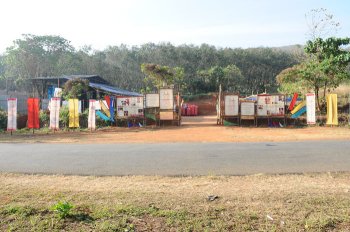
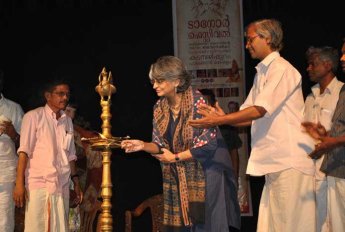
It was in this context that a five-day-long National Theatre Festival that happened in Kadambazhipuram, a quiet village in Palakkad district, becomes a significant event in the cultural map of Kerala. Organised by Natyasastra, Kadambazhipuram, along with Kazhcha Film Society, Sreekrishnapuram (the neighbouring village), in association with Media Mill, Thiruvananthapuram, the festival showcased some good samples of Indian theatre, lining up some of the stalwarts of contemporary Indian stage. The theatre festival in fact formed the concluding part of a month long Tagore Festival. The Tagore Festival, celebrating the 150th birth anniversary of the great poet, presented a host of events including an artists’ camp, dance and music performances and a film festival, with ‘Tagore’ being the connecting thread. Needless to say, the theatre festival also had all the performances drawing upon Tagore literature. That this festival held at the rural level managed to bring down some of the best samples of contemporary Indian theatre was its most commendable aspect. Dr. Anuradha Kapur, the senior theatre person and Director of the National School of Drama, New Delhi, arrived with ‘Jeevit ya Mrit,’ a solo performance by the celebrated actor Seema Biswas, an alumnus of the NSD. Presented by Vivadi, New Delhi, it drew upon a poignant short story of Tagore that told the story of a widow who was forced into the no-man’s-land between life and death. Neelam Mansingh Chowdhry came from Chandigarh with her interpretation of yet another Tagore story, ‘The Wife’s Letter.’ Then, there was Naya Theatre, carrying on the legacy of the legendary theatre person, late Habib Tanvir, presenting the play ‘Raj Rakth,’ that drew upon Tagore’s play ‘Bisarjan,’ and ‘Rajarshi,’ one of his novels. 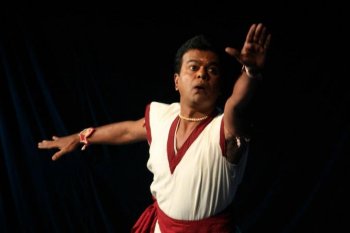 Khud aur Khuda 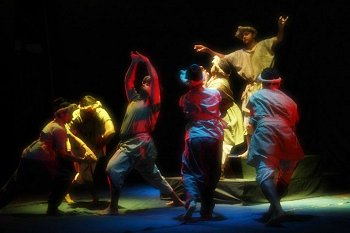 Chandalika The veteran theatre personality Kavalam Narayana Panikkar brought two of his works, ‘Khud aur Khuda,’ a multilingual solo performance, by V Gireesh, a senior actor with Sopanam, and ‘Chandalika,’ a full-fledged play. And, the hosts also came up with their own fare. The Natyasastra team presented a Malayalam version of Tagore’s ‘Bisarjan’ with the title ‘Bali’ directed by Naripatta Raju, an important name in the contemporary theatre scene of Kerala. A couple of short plays by Tagore were also presented by Thrissur Natakasangham. The festival was formally inaugurated by Dr. Anuradha Kapur, with eminent theatre person Maya Tangberg Grischin as the chief guest. However, the highlight of the whole festival was the scintillating performance of Seema Biswas, chiselled out under the sharp eyes of Dr. Anuradha Kapur. Without using the huge stage painstakingly designed by the organisers out of an abandoned laterite quarry, the Vivadi team chose a small alcove on the right side of the audience space. The space was levelled out overnight by the enthusiastic organising team. There, in a cozy, earthen recess with a backdrop of trees lit up beautifully against the sky, Seema portrayed the chilling tale of a woman – a widow – already ordained to a life in death, being condemned to another ‘death’ when she is mistakenly proclaimed as dead following a spell of unconsciousness. She wakes up in the cremation ground and realises that she cannot go back to the zamindar’s house, where she was already leading a virtually non-existent life following the death of her husband. The play traced the story of Kadambini, the protagonist, starting from the cremation ground, where she wakes up before the pyre is lit. Throughout the play, she moves back and forth through her memories. The play, even though being in Hindi, was well received by the local audience. The enthusiasm spilled over to the next day’s Meet the Artiste session also. 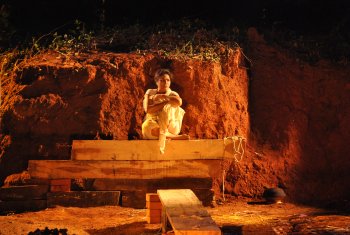 Seema Biswas 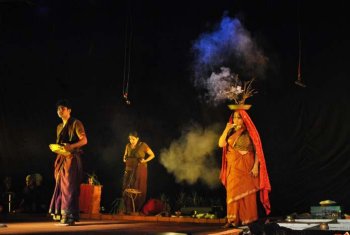 'A Wife’s Letter' ‘A Wife’s Letter,’ Neelam Mansingh Chowdhry’s adaptation of the Tagore story, ‘Streer Patra,’ was a fine sample of her oeuvre of well-designed plays, though the story somewhat went over the heads of the rural audience, mainly due to the language (Punjabi). The nuances of multi-casting that she applied with two actors, her senior performer Ramanjit Kaur and the male actor Vamsh Bhardwaj in a brilliant female impersonation, presenting the character of the child bride Mrinal. The character of Bindu, who arrives into the solitary life of Mrinal, was played by Gick Grewal, another senior performer with Neelam Mansingh Chowdhry’s The Company. The presence of the Punjabi folk singers, an integral part of Neelam Mansingh’s plays, added colour to the performance. Naya Theatre’s ‘Raj Rakth,’ directed by the late Habib Tanvir, now presented under the leadership of his daughter, Nageen Tanvir, kept to the language that characterised the theatre group, with the folk elements closely interwoven. Kavalam Narayana Panikkar’s ‘Chandalika,’ was also a fine sample of his oeuvre. ‘Khud Aur Khuda,’ a solo performance presented by V Gireesh and directed by Panikkar, presented some of the fundamental questions raised by Tagore, like relationship of Man and God. 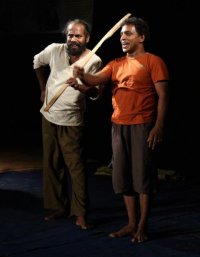 Post Office Naripatta Raju’s ‘Bali’ at the same time, contained the seeds of a good design and concept, which could not be chiselled out perfectly, mainly because the actors and director himself also formed part of the organising team, running about with the innumerable tasks and rushing off to rehearsals in between. The ‘Tagore Sketches’ and ‘Post Office,’ short plays written by Tagore, were presented by the team of Thrissur Natakasangham including CR Rajan, KB Hari, OC Martin, Prathapan, Mallu P Sekhar and Sudhi Vattappinni. 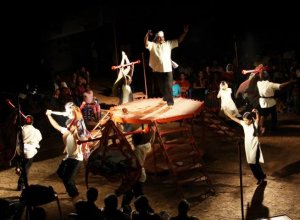 Bali 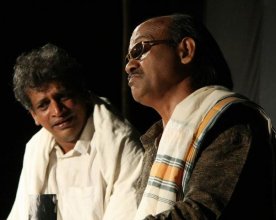 Sketches The theatre festival was in fact, the concluding chapter of the month-long Tagore Festival that Natyasastra has originally planned. The events kick started on November 26, 2011 with a solo performance of ‘Avani – A Handful of Dust’ by reputed dancer Dr. Anita Ratnam, which was followed by the premier staging of Narippatta Raju’s ‘Bali.’ The festival was formally inaugurated by the Kathakali maestro Kalamandalam Ramankutty Nair. The first three days of the festival, dedicated to dance and music, had the Mohiniattam performance ‘Chitrangada’ presented by Natana Kaisiki, Irinjalakuda, Rabindra Sangeet recital by NM Anoop and party, and the Kathakali performance ‘Shyama’ which was a rendering in Kathakali’s format of Tagore’s famed poem ‘Porishodh.’ The Attakkatha was composed by Radha Madhavan and the performance was directed by Latha Poduval with Kalamandalam Mohanakrishnan coordinating the whole effort. There were talks by Dr. KS Ravikumar, Head of Dept. of Malayalam, at Sree Sankaracharya University of Sanskrit, Kalady, N Radhakrishnan Nair, former secretary of Kerala Kalamandalam and NM Anoop. 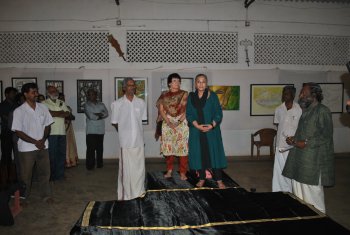 Exhibition inauguration 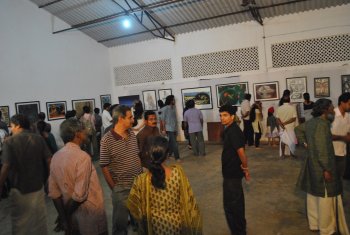 Painting exhibition The next phase of the festival was held with a three day long Artists Camp in which more than 15 leading contemporary artists from all over Kerala, including Rajan Krishnan, Bhagyanathan, Sanam, OC Martin, Sreeja P, Anto KG, Sudheesh K, Leon KL, Sebastian Varghese, Santhan NV, Pramod CG and Baiju Dev among others, participated. The works created during the camp were exhibited during the National Theatre Festival with Neelam Mansingh Chowdhry inaugurating the exhibition. Prints of paintings and drawings by Ravindranath Tagore were also exhibited during the festival. A film festival focussing on Tagore was the next in tow. The two day long Tagore Film Festival included ‘Nadeerpooja,’ a rare film that was directed by Tagore himself, the Satyajit Ray classics ‘Charulatha,’ ‘Teen Kanya’ and ‘Khare Baire,’ ‘Kabuliwala,’ directed by Heman Gupta, ‘Chokarbali’ directed by Rituparno Ghosh, ‘Khudito Pashan’ by Tapan Sinha and a documentary on Tagore made by Satyajit Ray. Interestingly, though there was no general curatorial attempt as such, this whole festival turned out to be woman-centric in theme, with the marked presence of women directors and performers or women-centric themes. This should be seen as significant, even if unintentional, as Tagore’s short stories and novels heavily drew upon the lives of women trapped in their domestic situations. Natyasastra Centre for Theatre Studies, founded in 1996, is the brainchild of Prof. G Dileepan, who was the driving force behind the month-long events. A teacher at VTB College, Sreekrishnapuram, Prof. Dileepan has been at the forefront of the Natyasastra team that organised a host of significant events of performing arts under the auspices of Natyasastra since its inception. Both the contemporary and classical theatre forms of Kerala are given equally importance space there. The group has produced more than 12 Malayalam plays besides organising a Bhasa Natakolsavam (2000), a festival of plays by Narippatta Raju (2001), a Kutiyattam Festival (2004) to mark the birth centenary of Guru Painkulam Rama Chakyar, Shakespeare Theatre Workshop and Film Festival (2005), Traditional Indian Theatre Festival highlighting Nangiarkoothu (2005), International Shakespeare Theatre Festival (2005), inaugurated by Habib Tanvir, Ramayanam Mela (2007) and KT Mohammed Memorial Theatre Festival (2009). There are many more events, too long to be listed out here. Natyasastra quietly continues its journey, without making tall claims, just intent on bringing quality theatre and performing arts to the people around. Renu Ramanath is a writer and columnist based in Kochi. She has covered art and culture extensively for The Hindu as a Staff Reporter in the Kochi bureau from 1996, writing reviews and features in The Hindu Friday Review and Sunday Magazine. Currently she edits Art Concerns, an online journal for contemporary Indian art. |